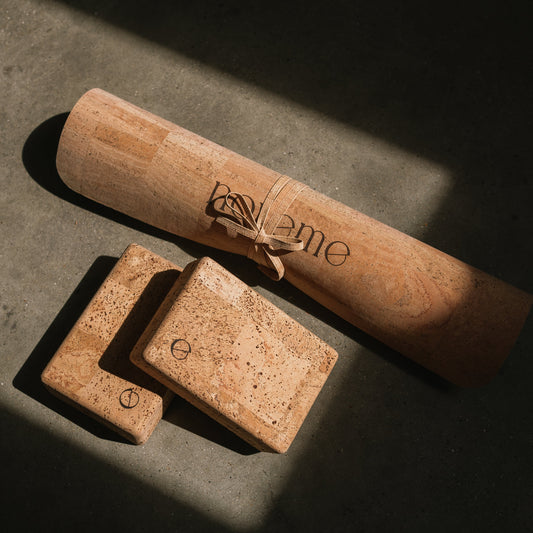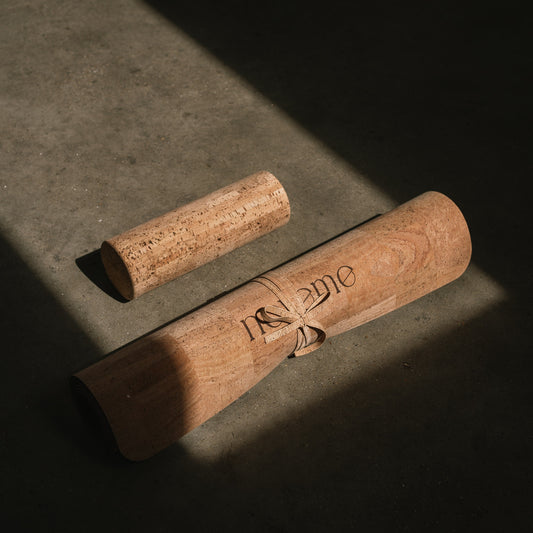Distinctive and timeless, cork is one of the most versatile and sustainable materials in the world. 100% natural and refreshingly uncomplicated, this material is used to make an endless array of cork products, from wine stoppers to yoga equipment.

WHAT IS CORK?
Cork is a natural plant tissue that comes from the bark of the cork oak tree (Quercus suber). It is such an extraordinary natural material that no industrial, laboratory or technological process has yet been able to mimic its properties.
KEY CORK MATERIAL PROPERTIES
- Light: Most of the volume of cork is air, making it a very light material.
- Waterproof: Thanks to the waxy substances present in the cell walls, cork is impermeable to liquids and gases.
- Hypoallergenic: Cork does not absorb dust, so it naturally prevents the appearance of dust mites.
- Fire Retardant: Cork burns without a flame and does not emit toxic gases while burning, making it a natural fire retardant.
- Renewable, Recyclable and Reusable: The cork oak is the only tree that regenerates its outer bark. It is also an extremely durable material that can be recyclable and reusable, thanks to the natural wax-like content of cork that protects it from rotting or decomposing.
- Biodegradable: it is a 100% natural product and therefore biodegradable.
- Smooth texture: Cork is warm, soft to the touch and has a pleasant, slightly sweet odour, all of which combined provide amazing sensory experiences.
HOW IS CORK HARVESTED?
Cork is first harvested when a tree is about 25 years old. The harvesting is carried out from May to August when the tree is at its most active phase of growth and it is easier to remove the bark from the trunk.
It is harvested by highly skilled professionals known as ‘descortiçadores’ who carefully remove the bark from the cork oak tree by hand, using only an axe. As the world’s best-paid seasonal agricultural job, it is carried out with no machinery involved and without any tree being felled or damaged during the process.
The cork oak tree is the only tree whose outer bark regenerates, acquiring a smoother texture after each harvest.
Each tree is harvested once every nine years over the course of its lifetime, which is up to 200 years. A single cork oak may be harvested around 16 times. This means that cork is not only a natural material but is also renewable.
The cork oak is the only tree that regenerates its outer bark. Cork is not only a natural material but is also a renewable resource.

WHERE DOES CORK COME FROM?
The cork oak tree is native to the Mediterranean Basin. Portugal is the home of the world’s largest cork forest and the world leader in cork production, responsible for about half of the world’s cork.
The cork oak tree has been designated as Portugal’s national tree since 2011 and has been protected by law since the 13th century — it is illegal to cut down a cork oak tree, and special permission is needed to fell old and unproductive trees.
At Noveme, we only use natural cork from Portugal as part of our dedication to using sustainable materials of the highest quality.

HOW IS CORK SUSTAINABLE?
Cork is one of the world’s most sustainable materials, not only due to its amazing properties, but also for the important environmental, social and economic impact of the cork oak forests.
Cork oak forests are beautiful habitats and the foundation of an important ecosystem for preserving biodiversity. Several rare and endangered species find ideal conditions for survival in the cork oak forest, including the endangered Iberian imperial eagle and the Iberian lynx.
Cork oak forests also play an important role in protecting the soil against erosion, decreasing the risk of desertification. Moreover, they provide a barrier against fire, thanks to cork’s fire-retardant properties.
They also provide an essential contribution to the air we breathe by absorbing carbon dioxide, the major cause of global warming. Cork oak forests are natural CO2 retainers, so the more this wonderful tree is harvested, the more it increases its ability to absorb CO2.
The more a cork oak tree is harvested, the more it increases its ability to absorb CO2.
In cork production, nothing is wasted. Even the smallest residues are used to create by-products that can be made into flooring, granulated stoppers and other cork-based products.
FROM BARK TO YOGA MAT

Bring the amazing properties of cork to your yoga practice with Noveme's Natural Yoga Mat.
Our mats combine a top layer crafted with slices of 100% natural cork with a high-quality natural rubber base that provides stability and cushioning for maximum comfort.











